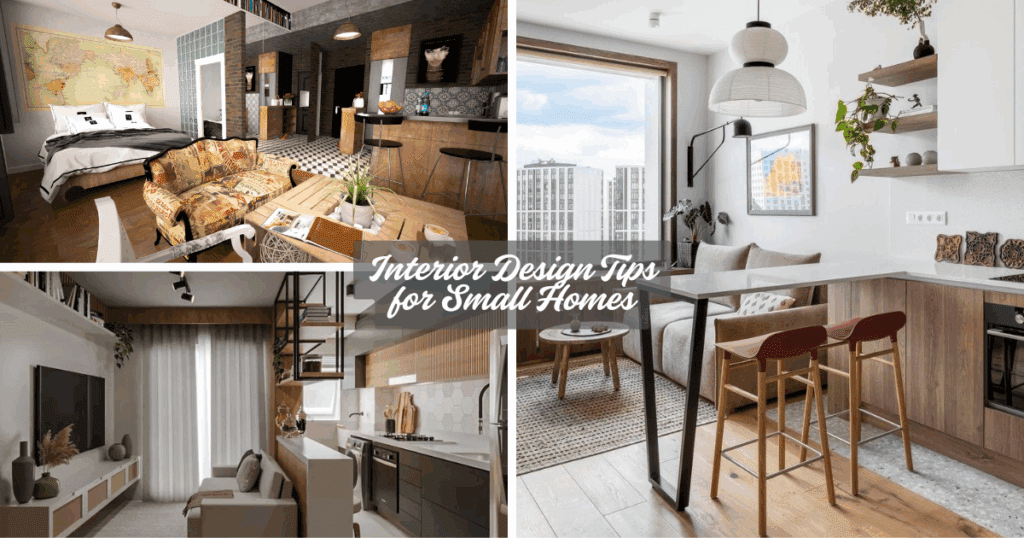
Living in a small home or apartment doesn’t mean sacrificing style or comfort. While small spaces can present challenges, they also offer great opportunities to get creative with your design. With the right approach and interior design tips for small homes, even the coziest spaces can make a big impact.
In this guide, we’ll be giving you tips that will enable you to maximize every inch. From choosing compact furniture to picking colors that create the illusion of more space, you’ll learn how to turn your small space into a chic and functional retreat. Let’s begin!
Outline
- The Challenges and Opportunities of Small Spaces
- Common Issues in Small Homes
- The Power of Creative Design Solutions
- Maximizing Space with Smart Furniture Choices
- Multi-Functional Furniture
- Space-Saving Pieces
- Furniture Arrangement Tips
- Using Color to Make Your Space Feel Larger
- The Role of Color in Small Spaces
- Light vs. Dark Colors
- Accent Colors and Bold Statements
- Making the Most of Vertical Space
- Wall Storage Solutions
- Using Vertical Lines to Create Height
- Lighting: The Secret to Enhancing Small Spaces
- Natural Light: Letting in the Sunshine
- Layered Lighting Techniques
- Statement Lighting Fixtures
- Decluttering and Organizing for a Clean, Spacious Look
- The Importance of Decluttering
- Smart Storage Solutions
- Keeping Things Tidy and Minimal
- Creating Zones in an Open Floor Plan
- Defining Spaces Without Walls
- Using Rugs, Furniture, and Lighting to Separate Areas
- Adding Personal Touches Without Overcrowding
- Decor Ideas for Small Spaces
- Balancing Aesthetic and Functionality
- Conclusion
- Embrace the Charm of Small Living
- Finding Your Style Within Limitations
1. The Challenges and Opportunities of Small Spaces
Small homes can be tricky, but they also offer unique chances for creative, personalized design. The key is making the most out of what you have, without overcrowding the space. Here’s a look at the common challenges and creative ways to deal with them.
Common Issues in Small Homes
The biggest problem in a small home is usually a lack of storage. Without enough storage options, your space can quickly get cluttered and feel even smaller. Limited natural light and tricky layouts are also common problems, especially in apartments with few windows or open walls.
The Power of Creative Design Solutions
Despite these issues, small spaces encourage innovative design ideas. From space-saving furniture to clever storage tricks, small homes push you to think outside the box. With a little creativity, you can transform a cramped space into a stylish, functional home.
2. Maximizing Space with Smart Furniture Choices
When dealing with a small living area, the furniture you choose can make or break the space. Look for furniture that saves space or serves more than one purpose so you can keep your home organized without losing comfort or style. Interior design tips for small homes emphasize the importance of selecting the right pieces for both function and aesthetics.
Multi-Functional Furniture
In compact spaces, multifunctional furniture can be innovative and impactful. For example, a sofa that turns into a bed or a table that doubles as a desk can help you save space while keeping everything functional. Try to find pieces that adapt to your needs, like expandable tables or storage ottomans.
Space-Saving Pieces
Every piece of furniture in a small home should serve a purpose. Look for compact, space-saving options like foldable dining chairs, nesting tables, or wall-mounted shelves. These pieces help keep your home neat and make sure you’re using every inch wisely.
Furniture Arrangement Tips
How you arrange your furniture is also important. Avoid pushing everything against the walls, as that can make the space feel closed off. Instead, try creating open pathways and leaving space around each piece. In a small living room, for example, center the furniture around a coffee table or TV for better flow.
3. Using Color to Make Your Space Feel Larger
The colors you choose can drastically change how a room feels. When designing small spaces, it’s important to understand how to use color to create the illusion of more space.
The Role of Color in Small Spaces
Light colors like whites, pastels, and soft greys can make a room feel more open and airy. On the other hand, dark colors can make a room feel cozy, but they can also make a space feel cramped if used too much.
Light vs. Dark Colors
While light colors are great for making rooms feel larger, dark colors can be used strategically for depth and contrast. Try dark accent walls, furniture, or accessories to highlight features without making the room feel smaller.
Accent Colors and Bold Statements
Want to add some personality? Bold accent colors like a bright rug or a colorful painting can give your space a unique touch without overwhelming it. Keep accent pieces small and spread out to maintain balance.
4. Making the Most of Vertical Space
In small homes, don’t forget to look up! Using vertical space is key when you need to add storage or create the illusion of height.
Wall Storage Solutions
Wall-mounted shelves, floating cabinets, or hooks are perfect for storing things without taking up floor space. Use these wall storage options to keep things neat while making your space feel bigger.
Using Vertical Lines to Create Height
Adding vertical lines can also make a room look taller. Try tall bookshelves, vertical artwork, or striped wallpaper to draw the eye upwards. This creates a sense of height and helps the room feel more open.
5. Lighting: The Secret to Enhancing Small Spaces
Good lighting can change the entire feel of a room, especially in small spaces. With the right lighting, your small home can feel more welcoming and airy.
Natural Light: Letting in the Sunshine
Let natural light in by keeping windows free of heavy curtains. Opt for light blinds or sheer curtains to brighten the space and create a more open, airy feel. If your home doesn’t get much natural light, mirrors can help reflect it, making the space feel brighter.
Layered Lighting Techniques
Layered lighting is a must in small spaces. Combine overhead lighting, task lighting (like desk lamps), and accent lighting (like wall sconces) to create a cozy, inviting atmosphere.
Statement Lighting Fixtures
Don’t shy away from bold lighting pieces. A statement light fixture, like a chandelier or pendant light, can add character to your small space. Just make sure it’s not too big or too bright—one striking light can add elegance without taking over.
6. Decluttering and Organizing for a Clean, Spacious Look
A clutter-free space is one of the easiest ways to make a small home feel bigger. Keep things organized and make use of hidden storage options to keep your space neat.
The Importance of Decluttering
Disorganization of furniture places can even make larger places look chaotic. Regularly declutter by getting rid of things you don’t need. You can also use a “one-in, one-out” rule to keep things from piling up.
Smart Storage Solutions
Use hidden storage options like under-bed drawers, storage ottomans, or shelving units. Wall storage and multi-functional furniture (like a bed with built-in drawers) can also help you keep everything in its place.
Keeping Things Tidy and Minimal
In small spaces, a minimalist approach works best. Keep décor simple and functional. Fewer items will help your home feel cleaner and more spacious.
7. Creating Zones in an Open Floor Plan
Open floor plans are common in small homes, but it can feel like one big room if you don’t define each area. Creating zones helps separate different parts of the room while still keeping the space open. Interior design tips for small homes often focus on finding ways to create distinct areas without sacrificing the open feel.
Defining Spaces Without Walls
Use rugs, furniture, or even different flooring to create distinct areas. A rug under the couch can define the living space, while another rug or a bookshelf can mark the dining area.
Using Rugs, Furniture, and Lighting to Separate Areas
Rugs, furniture, and lighting are all useful tools for creating zones. For example, a bookshelf or a console table can separate your living and dining areas, while lighting can highlight specific zones of your home.
8. Adding Personal Touches Without Overcrowding
Personal touches can make a small space feel like home, but it’s important not to overcrowd your space with too much. Keep things organized and intentional with your decor.
Decor Ideas for Small Spaces
In small homes, every piece of décor should serve a purpose, whether it’s functional or decorative. Choose statement pieces, like art or plants, that enhance your space without overwhelming it.
Balancing Aesthetic and Functionality
In a small home, the function should always come before form. Choose décor that is both practical and stylish to create a balanced look.
9. Conclusion
Living in a small home doesn’t mean you have to compromise on style. With the right interior design tips for small homes—like space-saving furniture, smart use of colour, and keeping things organized you can transform any small space into a beautiful, functional home. So, embrace the charm of small living and make the most of every inch!
